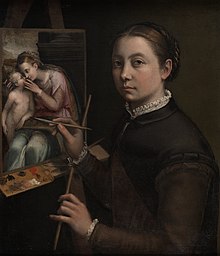Self-portraiture
This article needs additional citations for verification. (May 2024) |

Self-portraiture, ou Autoportraiture is the field of art theory and history that studies the history, means of production, circulation, reception, forms, and meanings of self-portraits.[1][2] Emerging in Antiquity and becoming popular from the Renaissance as an artistic practice, as a specific field of study, self-portraiture is recent, but it has been expanding rapidly.
History[edit]
Self-portraiture has a long history. In Reynolds & Peter's analysis, the handprints that prehistoric humanity left in cave paintings can be considered precursors of the self-portrait, as they are a direct document of the author's presence in the creative act and his perception of the existence of a "self". The self-portrait showing the artist's face or entire body appeared much later, with documented examples in Ancient Egypt and Classical Antiquity.[3]
In the Middle Ages the practice began to gain momentum, following the growing appreciation of the question of authorship in the study of artistic works, and an appreciable number of self-portraits of scribes and copyists illuminate their books and parchments, mostly anonymous, survive.[4]
Throughout the Renaissance, with the humanistic valorization of the individual, the interest in personal representation experienced an explosive growth, with particular emphasis on the author himself, both in the visual arts and in literature. According to Teresa Ferreira.[5]
The advent of new technologies today, especially since the 1980s, has had an extraordinary impact on the practice of self-portraiture. Selfies, photographic self-portraits, have become common around the world.
For a long time, self-portraits were included as small details in larger works, usually works of a religious nature, but from the Renaissance onwards they began to appear in a more striking way, to soon gain full independence in autonomous works.[6]
Attention to self-portraiture is recent in the History of Art, although there are very old collections such as that of the Uffizi Gallery, in Florence, exhibited in the Vasari Corridor, the largest pictorial collection of self-portraits.
Interests[edit]

Self-portraiture as a theoretical field attempts to answer several questions in modern times, from the most basic: what is a self-portrait? Or, why over the centuries has the number and quantity of works dedicated to it grown? Or why selfies have become a global phenomenon? It is also the object of his interest to analyze the relationship between self-representation and reality, since self-portraits often do not aim at the mere faithful reproduction of objectively identifiable traits, but, being intentional constructions, they can be allegorical, idealizing, critical, symbolic, psychological, satirical, philosophical, reflective.[7]
The self-portrature as an academic study only emerged in the twentieth century. In fact, it was with the monograph of Ernst Benkard (1927)[8] and, later, that of Ludwig Goldscheider (1936)[9] that studies of the subject gained momentum. Benkard features 500 images and Goldscheider 263. But they don't do any further analysis. It was only in 1955 with Michelangelo Masciotta that an in-depth reflection of self-portraiture appeared.[10]
Very rare, in this period, works such as that undertaken by Erwin Panofsky in analyzing Allegory of Prudence of Titian. The renowned historian, in 1926, recognizes the painter's face when comparing certain characters present in the work as an unequivocal self-portrait of the artist, and makes an analysis.[11]
Researchers still investigate self-portraits because they unfold many aspects of the artist's personal life and perception of himself and his relationships with his social environment, his peers, his time, culture and history, question artistic language, communication, poetics and style (visual or literary), and intertwine the public and the private. Personhood and impersonality, being intertextual and polysemic works.[12] Another focus of the research is to analyze the changes in the understanding of the meaning of the self-portrait over the centuries and its reception.[13]
See also[edit]
References[edit]
- ^ Bourdieu, Pierre,Rules of Art: Genesis and Structure of the Literary Field Stanford: SUP (1996)".
- ^ Piper, Rhiannon Piper. The Significance of Self-Portraiture
- ^ Reynolds, Anna & Peter, Lucy. "Producing and collecting portraits of artists". In: Reynolds, Anna; Peter, Lucy; Clayton, Martin (eds.). Portrait of the Artist. Royal Collection Trust, 2016, pp. 9-12
- ^ Reynolds, Anna & Peter, Lucy. "Producing and collecting portraits of artists". In: Reynolds, Anna; Peter, Lucy; Clayton, Martin (eds.). Portrait of the Artist. Royal Collection Trust, 2016, pp. 9-12
- ^ Ferreira, Teresa Pinto da Rocha Jorge. Autorretratos na Poesia Portuguesa do Século XX. Doutorado. Universidade Nova de Lisboa, 2019, pp. 23-27 (in portuguese)
- ^ Enenkel, Karl & Liebregts, Peter. "Introduction". In: Enenkel, Karl; Jong-Crane, Betsy de; Liebregts, Peter (eds.). Modelling the Individual. Biography and Portrait in the Renaissance. Rodopi, 1998, pp. 1-10
- ^ Rangel, Cláudio. Por uma História da Autorretratística no Brasil. Niterói: Unilasalle, 2004. (in portuguese)
- ^ Benkard, Ernst. Das Selbstbildnis. Berlin, 1927
- ^ Goldscheider, Ludwig. Five Hundred Self Portraits from Antique Times to the Present Day in Sculpture, Painting, Drawing and Engraving. Vienna; London Phaidon Press; George Allen & Unwin Ltd
- ^ Masciotta, M.. Autorritratti dal XIV al XX Seculo. Milan, 1955
- ^ Panofsky, Erwin. Meanig in the Visual Arts. Chicago : University of Chicago Press, 1982
- ^ Caro, M. A. The native as image: art history, nationalism, and decolonizing aesthetics. Thesis. Universiteit van Amsterdam, 2010, pp. 155-157
- ^ Haifeng, Xuan. Modes of Painting in the Self-Portraits of Marlene Dumas. Master. University of the Witwatersrand, 2012, pp. 25-27
Sources[edit]
- Thomson, Duncan (2001-01-01). "self-portraiture". The Oxford Companion to Western Art. Oxford University Press. doi:10.1093/acref/9780198662037.001.0001. ISBN 978-0-19-866203-7.}}
